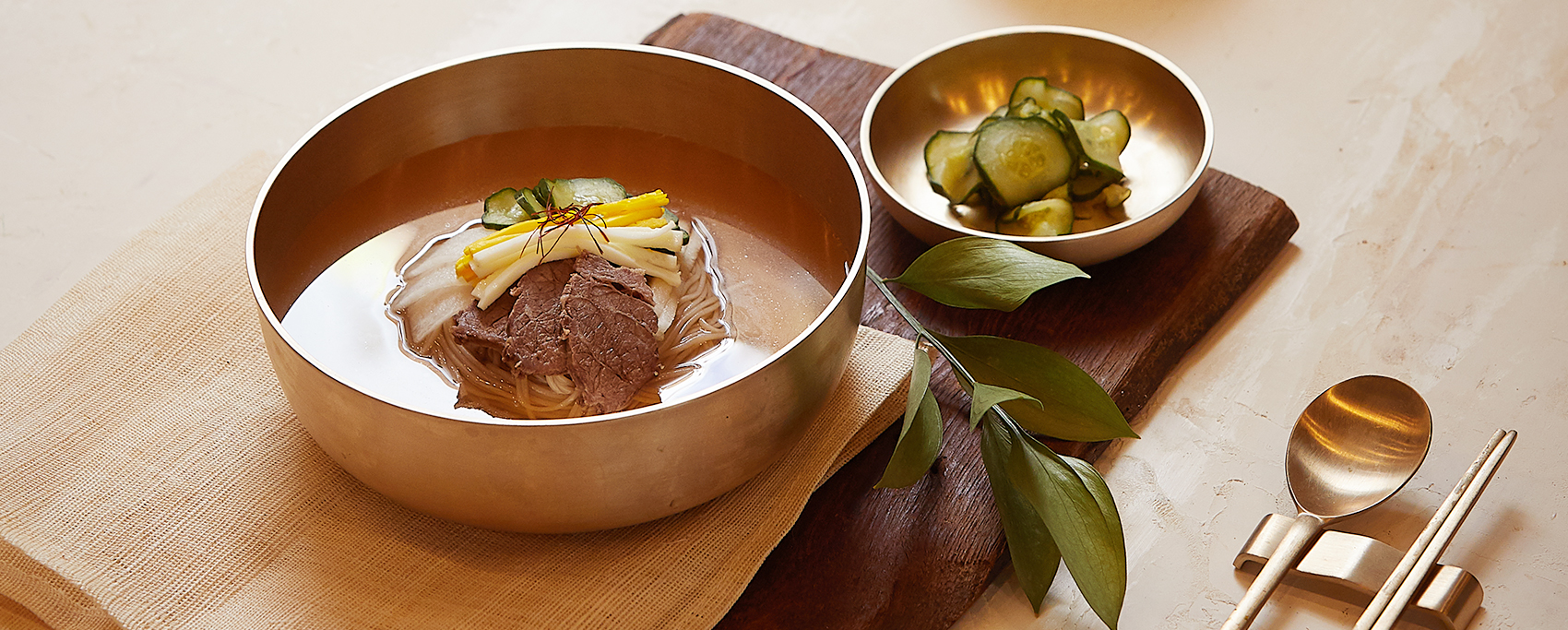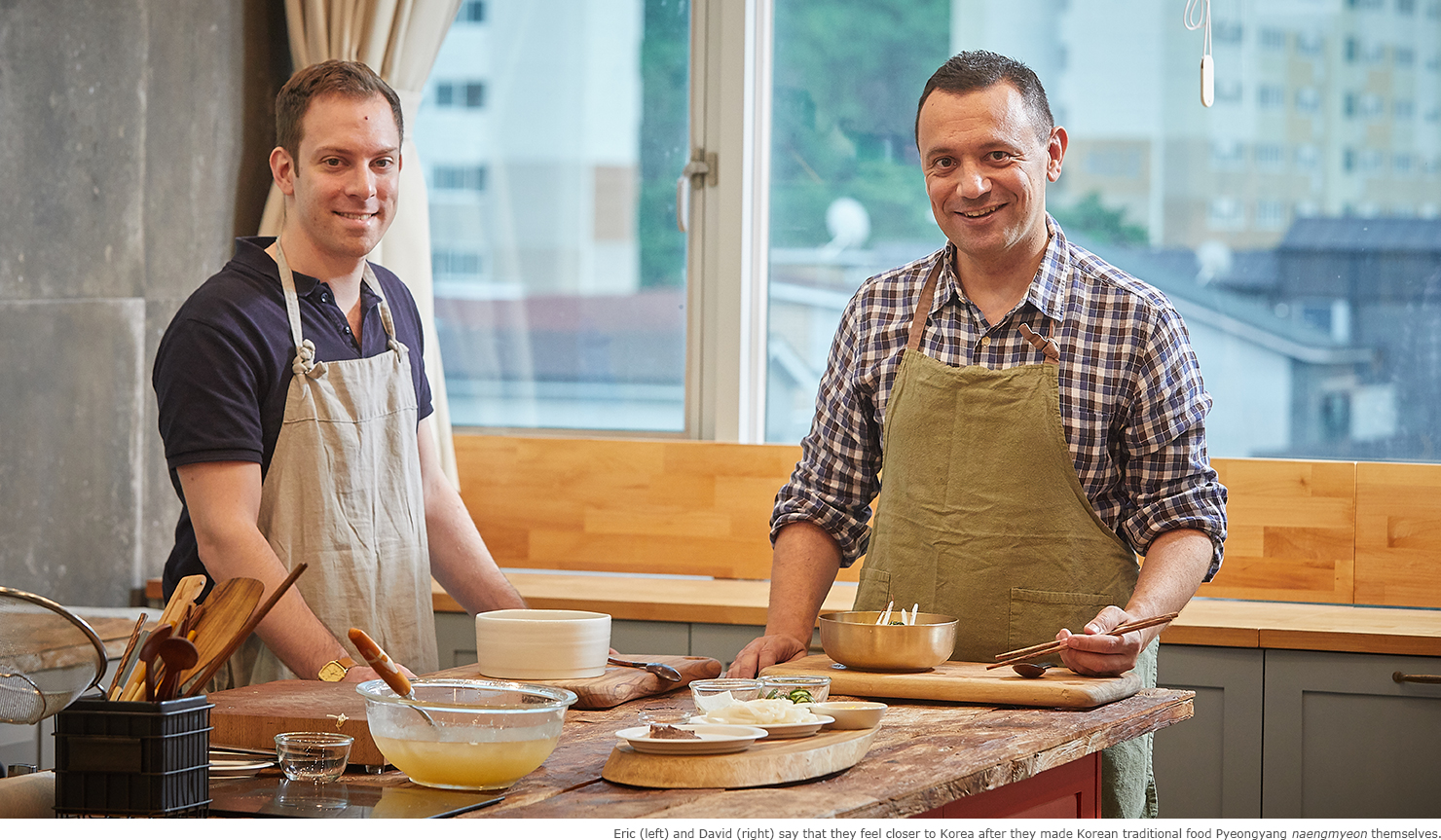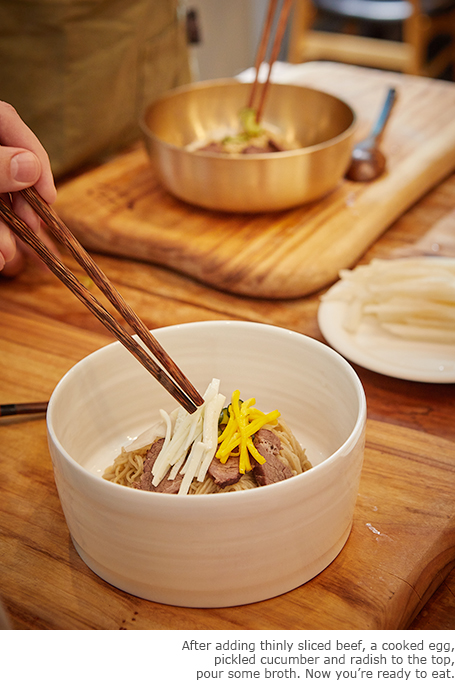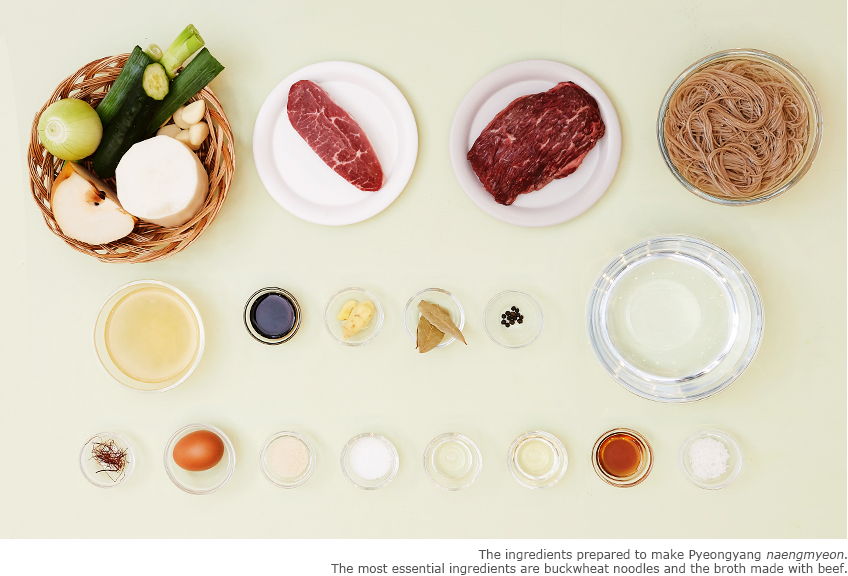
Contents





Master Weaver




in Korea


Pyeongyang Naengmyeon
Pyeongyang Cold Buckwheat Noodles
The hot summer weather brings out cravings for an ice-cold bowl of naengmyeon chilled noodles. Slurp the spongy noodles and wash them down with gulps of icy broth to chase away the fiery summer heat. Furthermore, the Inter-Korean Summit sparked a craze for Pyeongyang naengmyeon, a craze that’s far from over. So popular has the dish become, even the radishes that go into the ice broth are sold out. Pyeongyang naengmyeon is a dish with a refreshing broth and buckwheat noodles that help cool your body in the summer. Lightness is key to the flavor profile of the dish, which may seem bland to some. However, as you learn to appreciate the depth of the flavor, you will fall in love with its unique charms. Let’s dive into the world of Pyeongyang naengmyeon, an icy cold dish that has become a hot topic in 2018.
Written by Lee Ju-eun Photographed by Studio Kenn

So, what is Pyeongyang naengmyeon?
Pyeongyang naengmyeon is a local delicacy from Pyeongyang, North Korea. It consists of buckwheat noodles in a cold meat broth. Although in the past the broth used to be made of pheasant, beef and beef bones are used today.
Having long been the cultural and economic center of northwest Korea, the city of Pyeongyang, now the North Korean capital, has sprawling plains and is close to the West Sea. Thus, it’s abundant in both agricultural and marine produce, resulting in a famously diverse cuisine. The dishes are usually not heavily salted or spiced, and are generally characterized by a clean flavor profile. This is the culinary environment in which Pyeongyang naengmyeon was born.
This is also why Pyeongyang naengmyeon has a unique charm, which is not apparent at first, but which slowly wins you over, as told by numerous cold noodle aficionados.
Colleagues Cook a Refreshing
Summer Treat Together
David and Eric are old colleagues, working in the mobile division of a large company. David has already been living in Korea for 7 years, while Eric has been here for 6 years. Both of them are very happy with their lives in Korea, and call themselves “half Korean.” Perhaps it’s the camaraderie built over many years of working together in the same office in a foreign land. These two seem to be able to read each other’s minds, working together in seamless coordination.
Working together day in and day out, in the first Asian country in which either of them have lived, they have become friends who can count on each other for anything, no matter how small. It seems David takes care of Eric almost like a brother, and Eric greatly appreciates David’s presence in his life.

Married to a Korean, David is more familiar with indigenous heritage, traditions and cuisine. He has made jjimdak braised chicken and bulgogi marinated beef before, and thinks that naengmyeon will be no challenge at all. He’s confident that he’ll be able to make it himself and introduce it to our readers. Perhaps it seems that the dish will be as simple to make as it is to eat. Eric has only eaten the local fare, and has never made any himself. He seems worried, wondering if he will be able to make and introduce the dish at the same time. However, this mood passes quickly, as he selects an apron to match his outfit and starts posing like a star chef. This is followed by a confident, “I’m ready to cook!”

Rich Broth With Ice Floating On Top
The first step is making the meat broth, using a pot full of water.
“Which cuts of beef are used? Do you have to use beef raised in Korea, or can it be beef raised in Australia?” David’s questions are those of an experienced home chef, befitting a man coming from the tradition of French cuisine. He is intent on learning every detail involved in making the dish. On the other hand, Eric seems nervously excited as he admits, “It’s awkward for me even to be cutting vegetables with a knife. Is the cucumber too thick? Should I make it thinner?”
Although the dish looks simple, and is easy to eat, the preparation turned out to be quite a lot of work. Of course, this is true for any dish. The effort is what makes a dish work. Just look at gimbap rice rolls, which are eaten in minutes but which require the preparation of numerous ingredients. Still, Pyeongyang naengmyeon is a relatively simple dish to make without too many complicated steps. It’s actually quite easy to make at home, as long as you don’t have to make the buckwheat noodles from scratch.

Once the water containing two different cuts of beef starts to boil, onions, green onions and garlic are added, and the broth is brought to a boil again. The two friends laugh heartily as they joke, “Now, all we do is wait until morning for the broth to be done.” Making naengmyeon is all the more fun and enjoyable with comic relief from these two.
The meat broth is then combined with a dongchimi radish water kimchi in a 1:1 ratio. Apparently, this is the first time the two have seen dongchimi radish water kimchi. The tangy and sweet flavor of the radish water kimchi, made with water, radish and salt, is a refreshing experience for the two. Excitement is apparent on their faces as they taste the brine, wondering how the combination of the kimchi brine and the meat broth will taste.
Tasting Peace on the Korean
Peninsula Through Cold Noodles
Now it’s time to cook the buckwheat noodles in the boiling water. The noodles are cooked for just two or three minutes and then washed vigorously in cold water. The two friends remark that it’s the complete opposite of the method for boiling spaghetti or other types of European noodles. The teacher explains that Korean noodles are washed in cold water after cooking to eliminate the starch, which brings out the spongy texture and gives the noodles a more refreshing flavor.
Now the noodles are ready to be placed in a large bowl. They take the form of naengmyeon once the toppings are added. The noodles are rolled up into a neat ball, upon which toppings are placed. This step of garnishing brings out the different personalities of the two chefs. Eric goes into deep thought, asking, “Should I place the radish in a crisscross pattern, or should they be aligned?” On the other hand, David is as creative as a Michelin-starred chef in decorating his naengmyeon. After adding a suitable amount of toppings, he places a slice of pear upright and scatters slivers of chili, proclaiming it to be a cannon salute to welcome peace on the Korean Peninsula.


Pyeongyang naengmyeon has now become a symbol of peace. In fact, Pyeongyang naengmyeon will now forever be associated with peace. Each time these two eat a bowl of Pyeongyang naengmyeon, they will recall the happy memory of making the dish together with a trusted friend and colleague, as well as the atmosphere of peace that is filling the Korean Peninsula and spreading all around the world.
Cooking Tips

Ingredients

2L water, 300g brisket, 100g salchisal (chuck flap tail), 1 onion, 1 stalk green onion, 8 garlic cloves, 10 whole peppers, 3 bay leaves, 1 piece ginger, 1 cup dongchimi broth, Korean soy sauce to taste

1/3 radish, 1 tbsp vinegar, 1 tbsp sugar, pinch of salt

1/2 cucumber, 1 tbsp coarse salt, 1/2 tbsp plum syrup, 1 tsp sugar, 1/2 tbsp vinegar

170g noodles, 1/4 pear, 1 egg, pinch of shredded red chili
Other Articles





Master Weaver




in Korea

Application of subscription
Sign upReaders’ Comments
GoThe event winners
Go


 July 2018
July 2018


